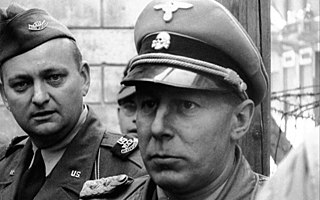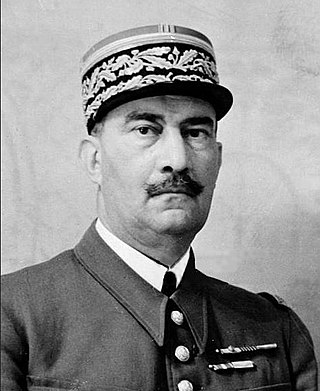
Palestine Final Fortress was the British 1942 defence plan for Mandatory Palestine at World War II against a possible German invasion from the north.

Palestine Final Fortress was the British 1942 defence plan for Mandatory Palestine at World War II against a possible German invasion from the north.
During World War II, Mandatory Palestine twice faced the danger of invasion by the German army and its allies. The first began when Nazi Germany conquered France in June 1940 and the rise of the pro-Nazi regime of Vichy France, which controlled Lebanon and Syria. This made the possibility of a German invasion from the north highly probable. That summer, the British armed forces started preparing a defence line against invasions from the north.
The following year, between June and July 1941, the British captured Lebanon and Syria from Vichy France. However, this had not removed the threat of a major German invasion from the north, as the British believed that the Red Army might not hold the line against Nazi Germany. Even though the defence line in the Soviet Union had been stabilized, the British made a strategic plan for the retreating troops out of Syria to be assembled in the mountainous region between Mount Carmel and the Jordan Rift Valley. This topography was believed to be effective against the Nazi German tank force (Panzerwaffe). This plan was referred to as Palestine Final Fortress (PFF) of "Defence of the Last Position Palestine". In early 1942, the British declared the Mount Carmel region a closed military area and began massive infrastructure work. [1]
In 1942, the threat of a German invasion from the south increased with the Afrika Korps advance into Egypt. Yishuv leaders discussed plans to defend against genocide of the Jewish population by the German army and by local Nazi supporters, which was expected in the event of British retreat from Palestine. [2] [3] The Hagana's "Plan of the North" included use of Palestine Final Fortress structures. The Yishuv also called their plan "Masada on the Carmel" and "Haifa-Masada-Musa Dagh". [4] Although the Yishuv had cause for worry during the 200 days of dread, no further actions were taken by the British nor by the Yishuv to prepare against possible invasion by the Axis powers. In late 1942, the threat of invasion from the south was lifted following the Allied victory in the Second Battle of El Alamein and the subsequent German retreat westwards across North Africa.

Free France was a political entity that claimed to be the legitimate government of France following the dissolution of the Third Republic. Led by General Charles de Gaulle, Free France was established as a government-in-exile in London in June 1940 after the Fall of France during World War II and fought the Axis as an Allied nation with its Free French Forces. Free France also supported the resistance in Nazi-occupied France, known as the French Forces of the Interior, as well as gained strategic footholds in several French colonies in Africa.
From 1939 to 1940, the French Third Republic was at war with Nazi Germany. In 1940, the German forces defeated the French in the Battle of France. The Germans occupied the north and west of French territory and a collaborationist régime under Philippe Pétain established itself in Vichy. General Charles de Gaulle established a government in exile in London and competed with Vichy France to position himself as the legitimate French government, for control of the French overseas empire and receiving help from French allies. He eventually managed to enlist the support of some French African colonies and later succeeded in bringing together the disparate maquis, colonial regiments, legionnaires, expatriate fighters, and Communist snipers under the Free French Forces in the Allied chain of command. In 1944, after the Allies had landed in Normandy and the southern front moved from North Africa across the Mediterranean into Italy and Provence, these forces routed the German Army, and Vichy officials fled into Germany.

Yishuv, HaYishuv HaIvri, or HaYishuv HaYehudi Be'Eretz Yisra'el denotes the body of Jewish residents in Palestine prior to the establishment of the State of Israel in 1948. The term came into use in the 1880s, when there were about 25,000 Jews living in that region, and continued to be used until 1948, by which time there were some 630,000 Jews there. The term is still in use to denote the pre-1948 Jewish residents in Palestine, corresponding to the southern part of Ottoman Syria until 1918, OETA South in 1917–1920, and Mandatory Palestine in 1920–1948.

The North African campaign of the Second World War took place in North Africa from 10 June 1940 to 13 May 1943. It included campaigns fought in the Libyan and Egyptian deserts and in Morocco and Algeria, as well as Tunisia. The campaign was fought between the Allies and the Axis Powers. The Allied war effort was dominated by the British Commonwealth and exiles from German-occupied Europe. The United States officially entered the war in December 1941 and began direct military assistance in North Africa on 11 May 1942.
A national redoubt or national fortress is an area to which the (remnant) military forces of a nation can be withdrawn if the main battle has been lost or even earlier if defeat is considered inevitable. Typically, a region is chosen with a geography favouring defence, such as a mountainous area or a peninsula, to function as a final holdout to preserve national independence and host an effective resistance movement for the duration of the conflict.

Almost every country in the world participated in World War II. Most were neutral at the beginning, but only a relative few nations remained neutral to the end. The Second World War pitted two alliances against each other, the Axis powers and the Allied powers. It is generally estimated that a total of 74 million people died, with the lowest estimate being 40 million dead and the highest estimate being 90 million dead. The leading Axis powers were Nazi Germany, the Empire of Japan and the Kingdom of Italy; while the British Empire, the United States, the Soviet Union and China were the "Big Four" Allied powers.

The Syria–Lebanon campaign, also known as Operation Exporter, was the invasion of Syria and Lebanon in June and July 1941 by British Empire forces, during the Second World War.

Walter (Walther) Rauff was a mid-ranking SS commander in Nazi Germany. From January 1938, he was an aide of Reinhard Heydrich firstly in the Security Service, later in the Reich Security Main Office. He worked for the Federal Intelligence Service of West Germany (Bundesnachrichtendienst) between 1958 and 1962, and was subsequently employed by the Mossad, the Israeli secret service. Recruited by Augusto Pinochet, Rauff played a role in the creation of the Chilean internal security apparatus during the military dictatorship. His funeral in Santiago, Chile, was attended by several former Nazis.
Battle Honours are awarded by the Sovereign to Royal Air Force squadrons to commemorate the squadron's role in a particular operation.

The Mediterranean and Middle East Theatre was a major theatre of operations during the Second World War. The vast size of the Mediterranean and Middle East theatre saw interconnected naval, land, and air campaigns fought for control of the Mediterranean, North Africa, the Horn of Africa, the Middle East and Southern Europe. The fighting lasted from 10 June 1940, when Italy entered the war on the side of Germany, until 2 May 1945 when all Axis forces in Italy surrendered. However, fighting would continue in Greece – where British troops had been dispatched to aid the Greek government – during the early stages of the Greek Civil War.

Fawzi al-Qawuqji was a leading Lebanese-born Arab nationalist military figure in the interwar period. The British military were impressed by his military acumen when he served briefly in Palestine in 1936 fighting the British Mandatory suppression of the Palestinian Revolt. A political decision by the British enabled him to flee the country in 1937. He was based in Nazi Germany during World War II, and served as the Arab Liberation Army (ALA) field commander during the 1948 Palestine War.

Einsatzkommando Egypt was the name assigned to an SS unit led by SS-Obersturmbannführer Walther Rauff, which was formed in occupied Greece during World War II awaiting deployment to North Africa, once the Afrika Korps had conquered Egypt and moved into Mandatory Palestine. Einsatzkommandos were paramilitary death squads that operated within German occupied territories.

Henri Fernand Dentz was a general in the French Army who served with the Vichy French Army after France surrendered during the Second World War. He was tried as a collaborator after the war.

The 200 days of dread was a period of 200 days in the history of the Yishuv in British Palestine, from the spring of 1942 to November 1942, when the German Afrika Korps under the command of General Erwin Rommel was heading east towards the Suez Canal and Palestine.
The 1947–1948 civil war in Mandatory Palestine was the first phase of the 1947–1949 Palestine war. It broke out after the General Assembly of the United Nations adopted a resolution on 29 November 1947 recommending the adoption of the Partition Plan for Palestine.
The French State, popularly known as Vichy France, as led by Marshal Philippe Pétain after the Fall of France in 1940 before Nazi Germany, was quickly recognized by the Allies, as well as by the Soviet Union, until 30 June 1941 and Operation Barbarossa. However, France broke with the United Kingdom after the destruction of the French Fleet at Mers-el-Kebir. Canada maintained diplomatic relations until the occupation of Southern France by Germany and Italy in November 1942.
The Army of the Levant identifies the armed forces of France and then Vichy France which occupied, and were in part recruited from, the French Mandated territories in the Levant during the interwar period and early World War II. The locally recruited Syrian and Lebanese units of this force were designated as the Special Troops of the Levant.
Operation Atlas was the code name for an operation carried out by a special commando unit of the Waffen SS which took place in October 1944. It involved five soldiers: three who were previously members of the Templer religious sect in Mandatory Palestine, and two Palestinian Arabs who were close collaborators of the mufti of Jerusalem, Amin al-Husseini.
Operation Boatswain was the first of the operational missions carried out by the Palmach as part of the cooperation between the Jewish Yishuv in Mandatory Palestine and the British during World War II. The mission to sabotage oil refineries in Tripoli was unsuccessful, ending with the disappearance of 23 Palmach commandos and British SOE officer Major Sir Anthony Palmer after their boat was lost at sea on 18 May 1941.

Hasan Salama was a Palestinian Arab nationalist guerrilla leader and commander who led the Palestinian Holy War Army in the 1948 Palestine War along with Abdul Qadir al-Husseini.